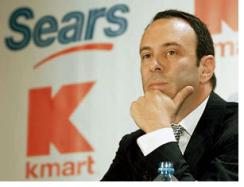Eddie Lampert is on a roll. The billionaire hedge fund manager is up at least 20 percent net of his fees through April after surging 53 percent last year. Don’t get too excited yet. His fund — ESL Partners — lost so much money in 2007 and 2008 that he is still well below his high water mark.
But we’re not exactly passing the hat around for Lampert. Even though he is not earning a performance fee from his long-time investors, he still managed to personally pocket more than $1 billion last year just from gains on his own dough parked in the fund.
Lampert is best known for his controlling position in Sears Holdings — the sad sack discount chain that owns Sears and Kmart, which were long ago overcome by Walmart and Target. He’s also known for being kidnapped several years ago before talking his captors into freeing him a few days later.

This is what happens when about two-thirds or so of your assets are tied to dying retailers such as Sears and Kmart, as was the case several years ago. So, why the turnaround? For some reason investors have fallen back in love with Sears, its stock quadrupling since late 2008. Sears’ customers, however, are still shunning the company. Sales at stores open at least a year have been declining every quarter since Lampert took over the company in 2004, although they have slightly turned upward at Kmart the two most recent quarters. Too little, too late, though.
So far this year, Sears, which now accounts for about half Lampert's $11 billion in equity assets, is up about 50 percent. Autozone, an auto parts retail chain that accounts for about one-quarter of his equity assets, is up nearly 18 percent this year while AutoNation, a chain of auto dealerships, is up 7 percent. Earlier this month, ESL and affiliates bought another 972,829 shares of AutoNation for an average price of $18.29.
Altogether, at year-end ESL had positions in the stocks of 11 U.S. companies, according to the most recent SEC filing (we’ll get a March 31 snapshot in two weeks). Yet, even though ESL, which managed about $11.8 billion at year-end, including cash holdings, is up more than 20 percent so far this year, longtime investors are still not jumping for joy. For one thing, Lampert still needs to be up another 16 percent or so to finally reach his high water mark — the break even point for those who were in for the two-year ride down from 2007-2008.
At least one investor tells me his is puzzled by Lampert’s run, which is still heavily dependent upon Sears. He thinks one factor that fueled Sears’ surge was a large amount of short interest on the stock, which made it expensive to borrow. So, part of the stock’s run-up could be due to heavy duty short covering.
Otherwise, the investor, who asked not to be named, is not sure what operationally is lifting the stock. He is not even sure what Lampert’s end-game is for the retailer.
Meanwhile, some observers were a little surprised in March when ESL purchased $100 million of commercial paper issued by Sears Roebuck Acceptance Corp., while Lampert himself purchased an additional $50 million of the paper.
On one hand, it was a shrewd investment, since the commercial paper purchased by ESL and Lampert had an interest rate of 1.9 percent, about 10 times the prevailing rate for high quality commercial paper.
“I thought it was insane to do that,” says one investor, who nonetheless voted for the required amendment to the ESL partnership agreement allowing the fund to make the investment, in part because it was an attractive yield. “I didn’t understand adding the debt exposure.”
You would think Lampert has enough exposure to Sears, and he wouldn’t also want to hold on to its debt as well.
Perhaps Sears’ stock is surging because investors once again think Lampert is the second coming of Warren Buffett. Don’t bet on it. Rather, he is simply the chairman of a crappy retailer with a lot of valuable real estate and fleeing customers.








